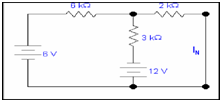Q: Determine the voltage Vo by Norton's theorem .

Sol:
We have to estimate V0 by Norton's theorem.
Step 1: Replacing RL with a short circuit to search IN.

Here RL is equal to 4k resistor.
Step 2:

We have to calculate IN.
By applying KVL for loop1
6kI1 +3k (I1 -I2) -12 -6 =0
9kI1 -3kI2 = 18
By applying KVL for loop 2
2kI2 + 12 + 3k(I2 - I1 ) = 0
-3kI1 +5kI2 = -12
Solving out equations for loop1 & loop2
I2 = -1.5mA
Therefore,
IN = -1.5mA
Step 3: Determining RN
To estimate RN we short circuit all of voltage sources. 3k is in parallel to 6k & 2k is in series with them.

6k||3k + 2k = (6k x 3k)/(6k+ 3k) +2k
= 2k +2k = 4k = RN
Step 4:
After estimating IN & RN, re-inserting the load resistance RL in the circuit in parallel RN and letting the IN current source parallel along these two resistances.

Current flow through RL= (-1.5m x4k)/8k (current division rule)
I0=- 0.75mA
Therefore
V0 = (-0.75m)(4k)= - 3volts